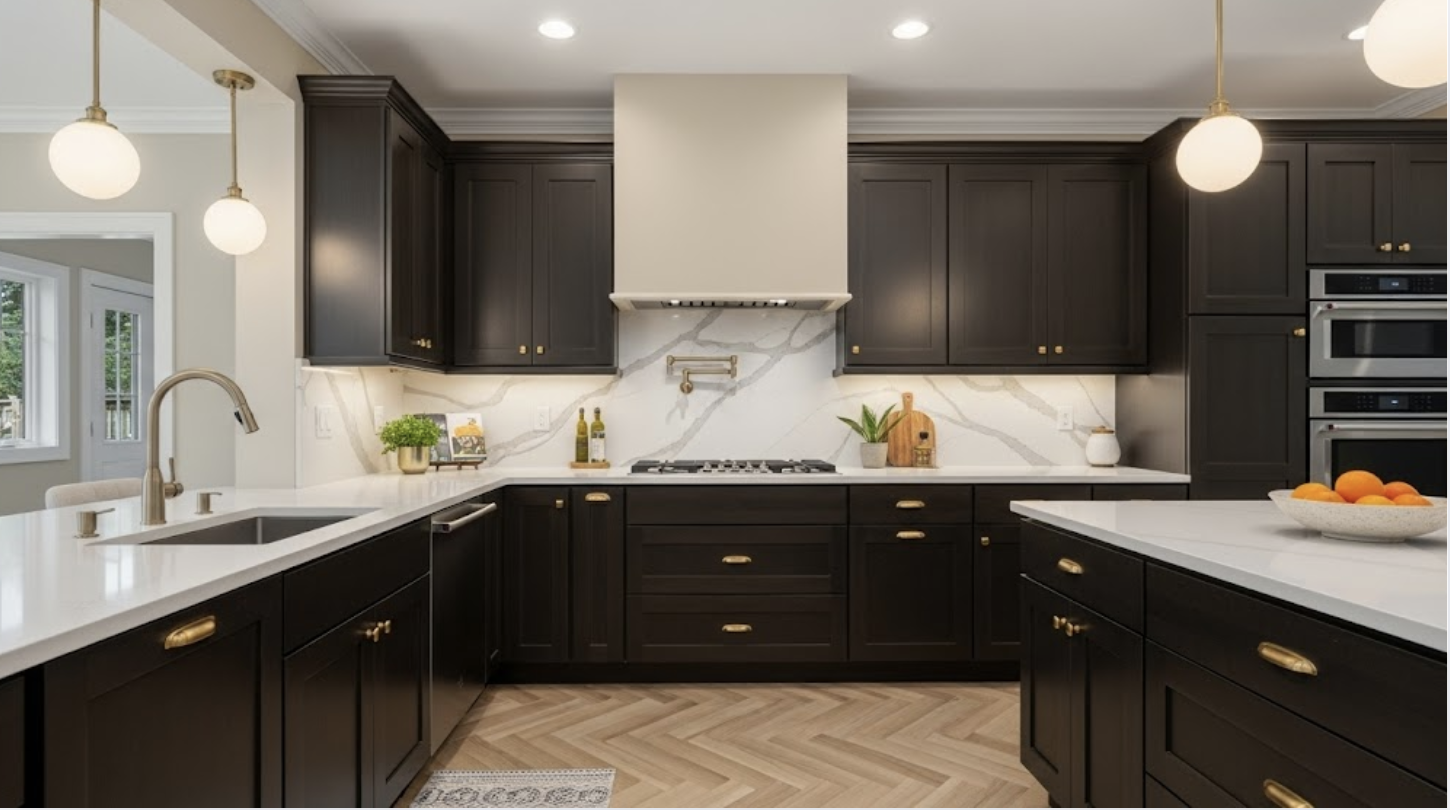When I remodeled my kitchen last year, I chose deep espresso cabinets. I loved their richness, but I quickly realized they made the room feel darker than I expected.
That’s when I started experimenting with color pairings to lift the space without losing the bold look I wanted.
If you’re working with dark cabinets, black, espresso, navy, or charcoal, you’re probably wondering which colors can bring the right contrast and balance.
Picking the right shades for your walls, backsplash, counters, and floors makes a huge difference.
In this blog, I’ll walk you through the top color schemes that work beautifully with dark kitchen cabinets. I’ve mixed in some personal insights and tested favorites to help you make confident choices that fit your style and space.
Why Color Schemes Matter with Dark Cabinets
Dark cabinets can create a bold visual statement in your kitchen, but they may make the space feel smaller.
By pairing them with the right wall colors, you can maintain an open, bright, and balanced atmosphere.
Lighter shades like whites, soft grays, or warm neutrals can reflect light and make the room feel spacious.
On the other hand, deeper tones like muted greens or rich blues provide contrast, adding depth and warmth without overwhelming the space.
Wall Colors That Complement Dark Kitchen Cabinets
Light tones like soft grays, whites, or warm neutrals balance dark cabinets and brighten the room. Deeper shades like blues or greens add contrast and warmth.
1. Crisp White Walls: Classic & Bright
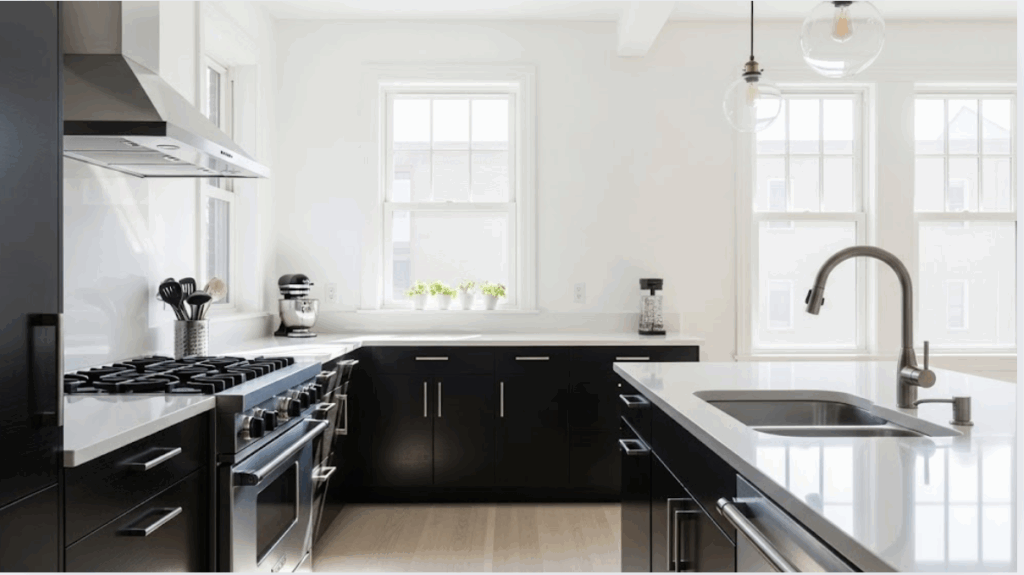
White walls provide a crisp contrast against dark cabinets, reflecting both natural and artificial light to make kitchens feel more open and airy.
This classic combination works particularly well in modern or transitional kitchens, offering a timeless, fresh look that enhances brightness while maintaining a clean, sophisticated aesthetic.
2. Soft Gray Walls: Neutral with a Twist
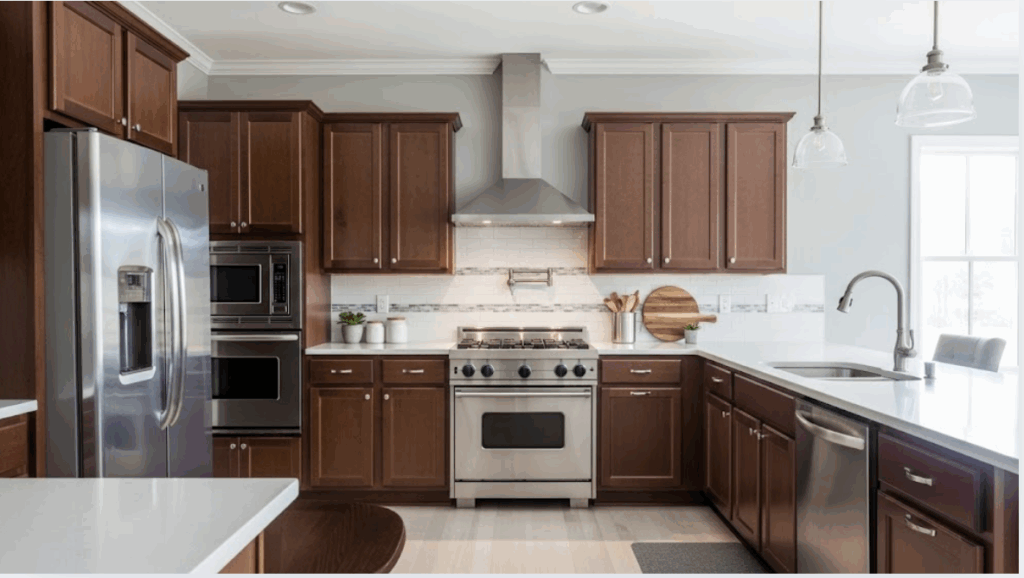
Soft gray tones offer a gentle contrast to dark cabinetry, adding warmth without overpowering the space.
They maintain a modern, relaxed feel and pair well with materials like stainless steel, marble counters, and glass tiles. This combination creates a fresh, updated look while keeping the kitchen comfortable and inviting.
3. Warm Beige or Greige: Soft and Inviting
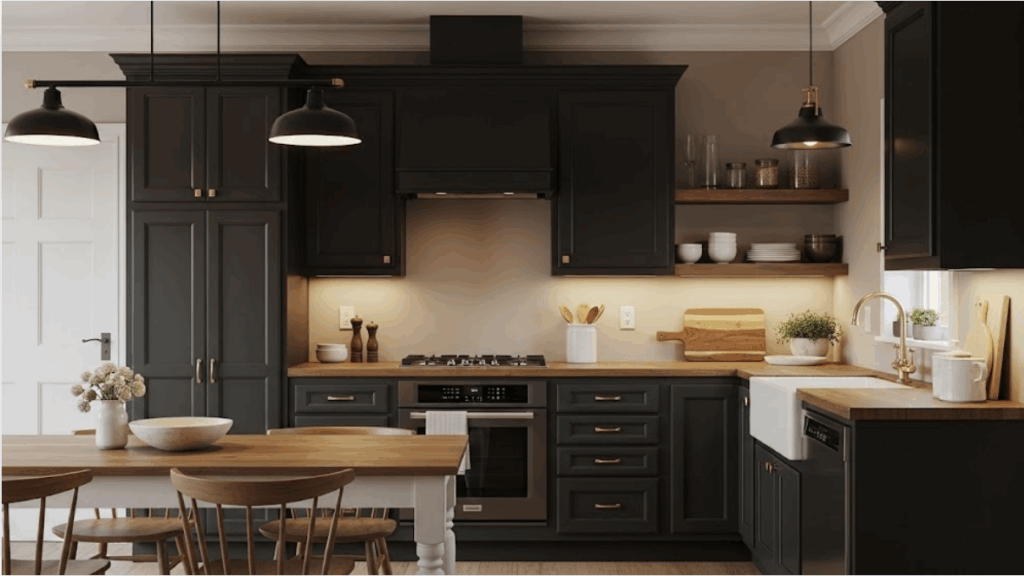
Beige and greige tones add warmth and create a cozy, lived-in vibe, making them perfect for kitchens with dark espresso cabinets.
These neutral shades seamlessly blend with wood accents and promote smooth transitions in open-plan spaces, connecting the kitchen with dining and living areas for a unified, inviting atmosphere.
4. Cool Blues: Calm and Fresh
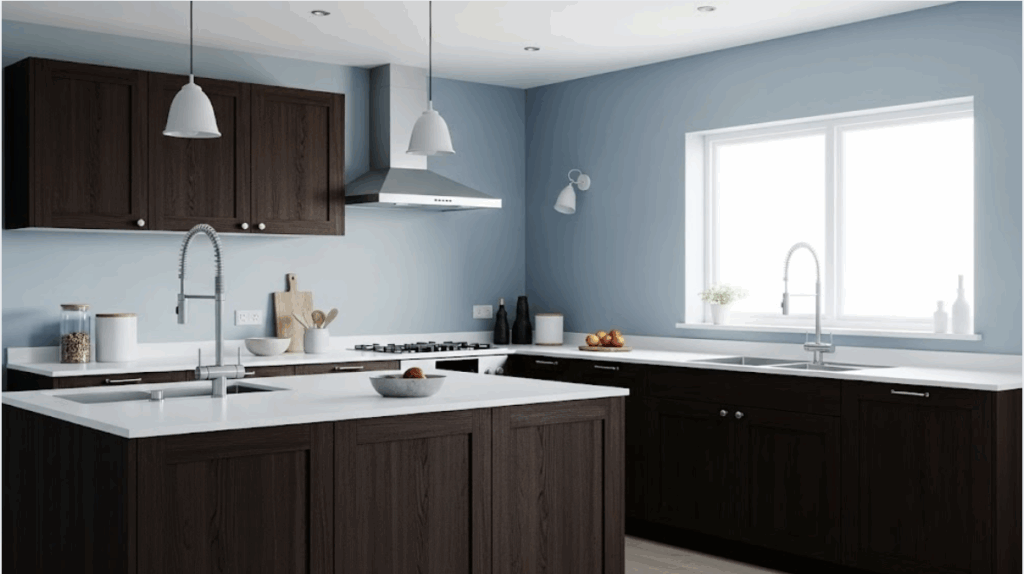
Soft or dusty blues provide a calming contrast to dark cabinetry, brightening the space and creating a fresh, serene atmosphere.
These shades pair beautifully with white countertops and nickel fixtures, making them perfect for coastal or casual kitchen styles, where a light, airy, and inviting ambiance is desired.
5. Earthy Greens: Natural and Peaceful
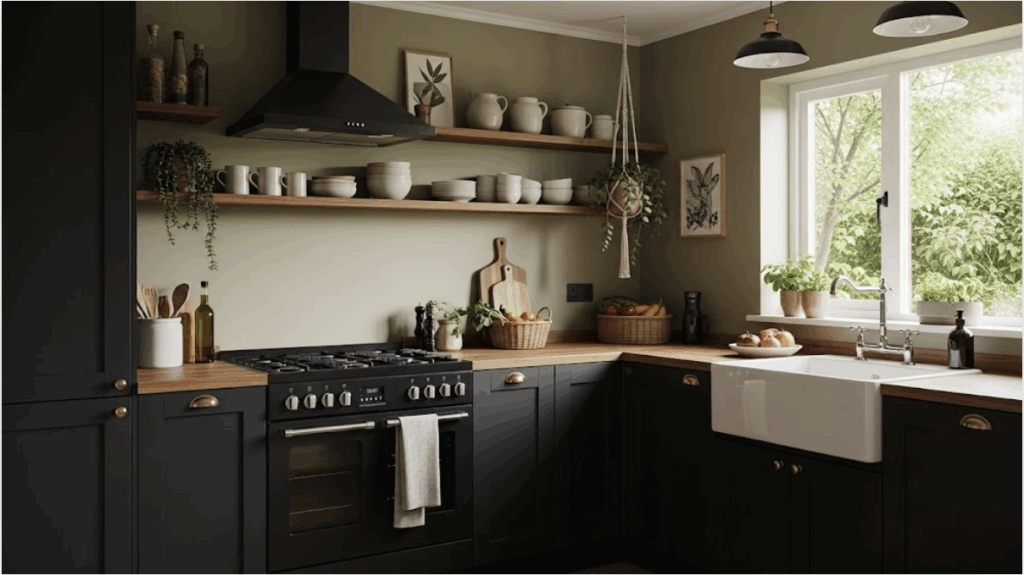
Shades of green, such as sage, olive, or moss, introduce a calming, natural element to the kitchen. These tones complement dark cabinets and wood details, creating a grounded, peaceful environment.
Ideal for cottage or nature-inspired spaces, they add depth and character without overwhelming the overall design.
6. Creamy Yellow or Buttery Tones: Sunny & Welcoming
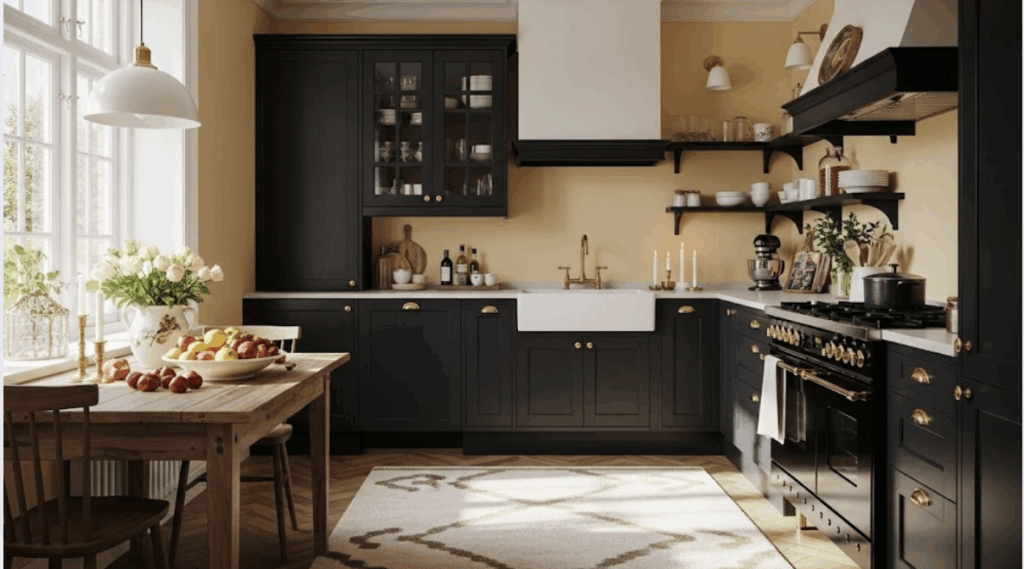
Soft yellow or buttery tones bring warmth and a welcoming feel to kitchens with dark cabinetry. These gentle hues add charm without overwhelming the space, making them ideal for farmhouse-inspired designs.
Paired with warm-toned hardware like brass or bronze, they create a cozy, balanced, and inviting atmosphere.
Backsplash Ideas That Work with Dark Cabinets
Backsplashes are a great place to add texture and reflectivity. They tie together your cabinets and counters while helping lighten the visual weight of the space.
1. White Subway Tile
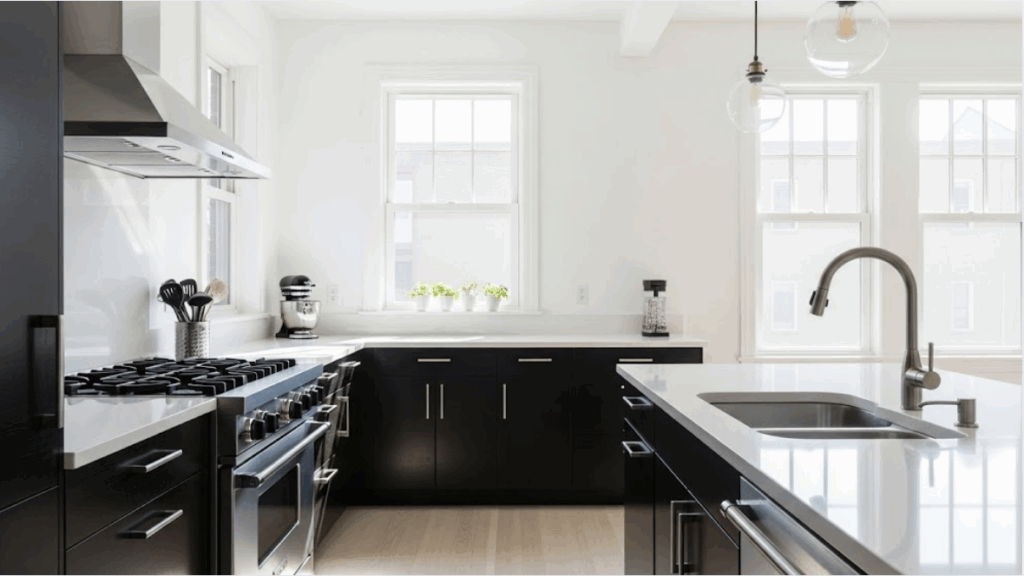
White subway tile remains a classic choice due to its simplicity, durability, and affordability. It offers a clean, timeless look that instantly brightens kitchens with dark cabinets.
Its sleek surface reflects light and provides a crisp contrast, making it ideal for both modern and traditional kitchen styles.
2. Marble-Look Tile
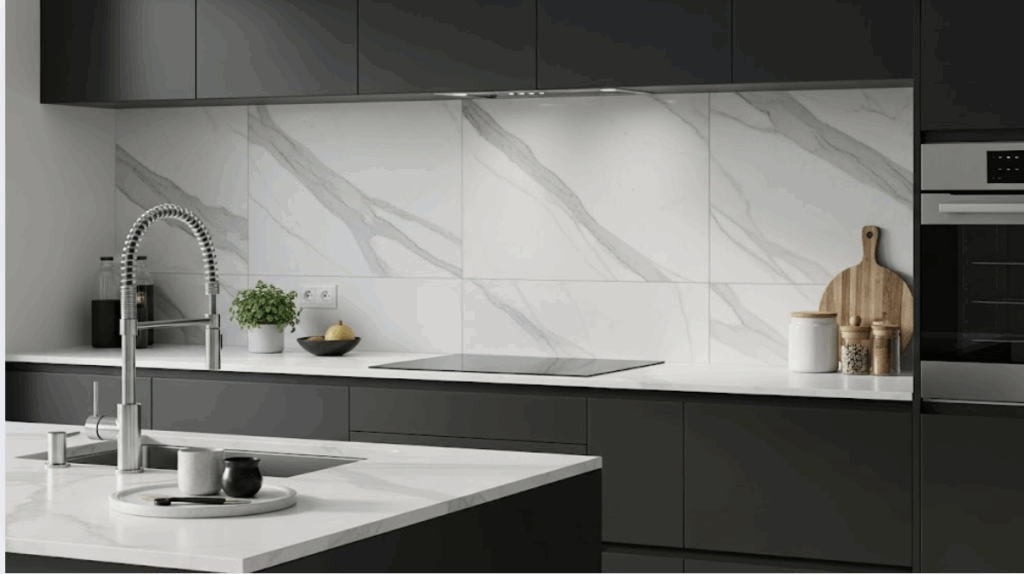
Marble-look tile adds refined texture and a clean, polished finish to kitchen surfaces. Its light gray or taupe veining introduces movement without overwhelming the design.
This subtle pattern works well alongside dark cabinets, helping to balance the space while contributing to a cohesive, upscale aesthetic.
3. Metallic Accents
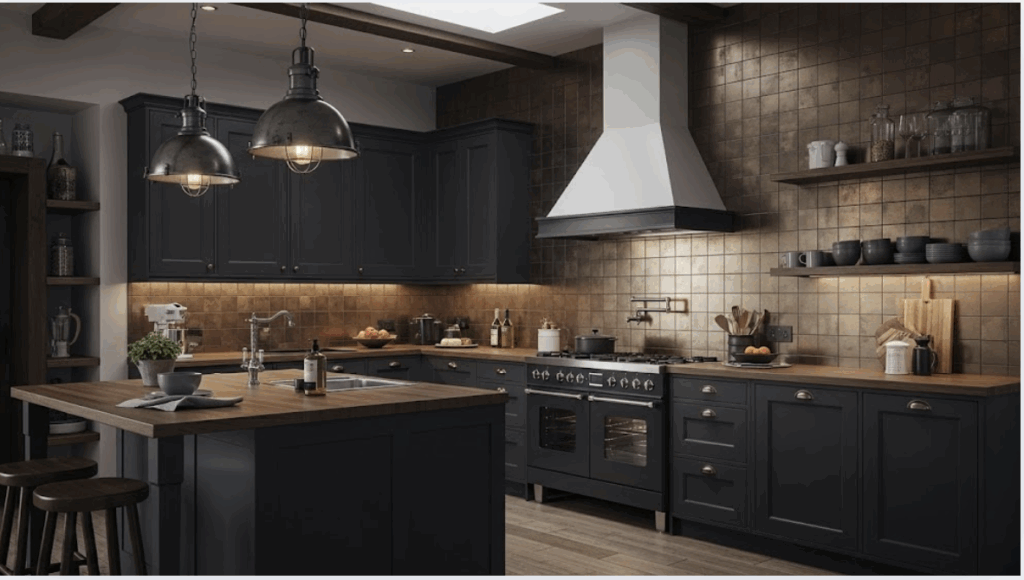
Metallic tiles in finishes such as brushed gold, bronze, or stainless steel offer a subtle shine that reflects light and brings warmth to the space.
They pair effectively with industrial fixtures or warm-toned hardware, adding texture and a modern edge without overpowering the overall kitchen design.
4. Glass Tile
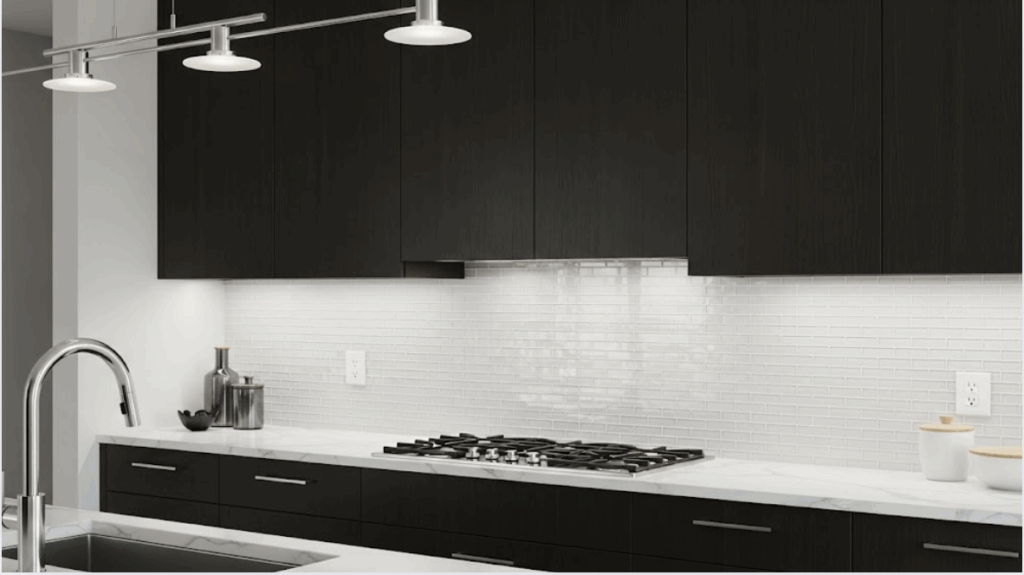
Glass tiles boost brightness by reflecting light, making them an excellent choice for kitchens with dark cabinets.
Options like frosted, clear, or muted tones can subtly catch the eye without overwhelming the design. These tiles add dimension and a clean finish, contributing to a more open, airy atmosphere.
Countertop Ideas to Match the Look
Your countertop choice can make or break your kitchen’s color flow. Light and textured counters can break up the boldness of dark cabinets.
1. White Quartz
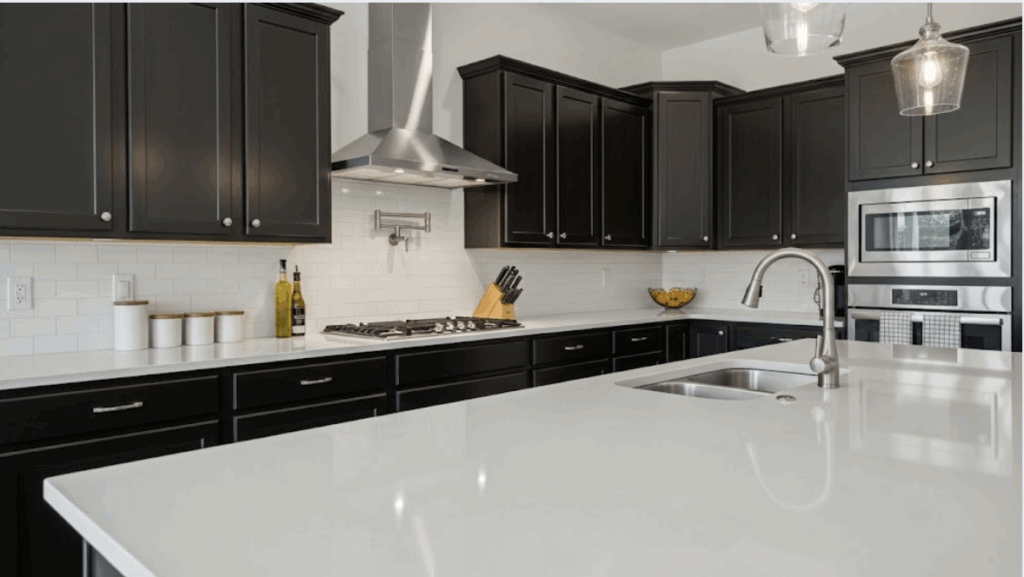
White quartz provides a crisp, low-maintenance surface that brightens kitchens with dark cabinetry. Its smooth, uniform finish works across design styles, whether modern, transitional, or farmhouse.
Durable and stain-resistant, it delivers both function and style, making it a versatile choice for homeowners seeking a clean, cohesive look.
2. Marble or Granite with Veining
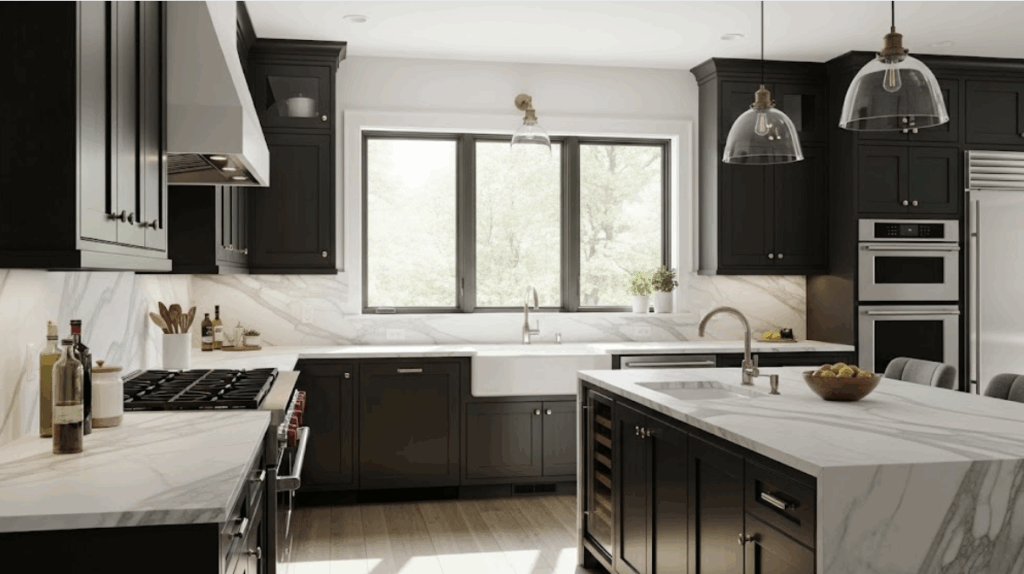
Natural stone countertops with light backgrounds and gentle veining add depth and visual interest while maintaining an airy feel.
They complement a wide range of cabinet colors, including dark tones, and bring a refined, polished look to the kitchen. This option balances elegance and warmth for a timeless design.
3. Butcher Block
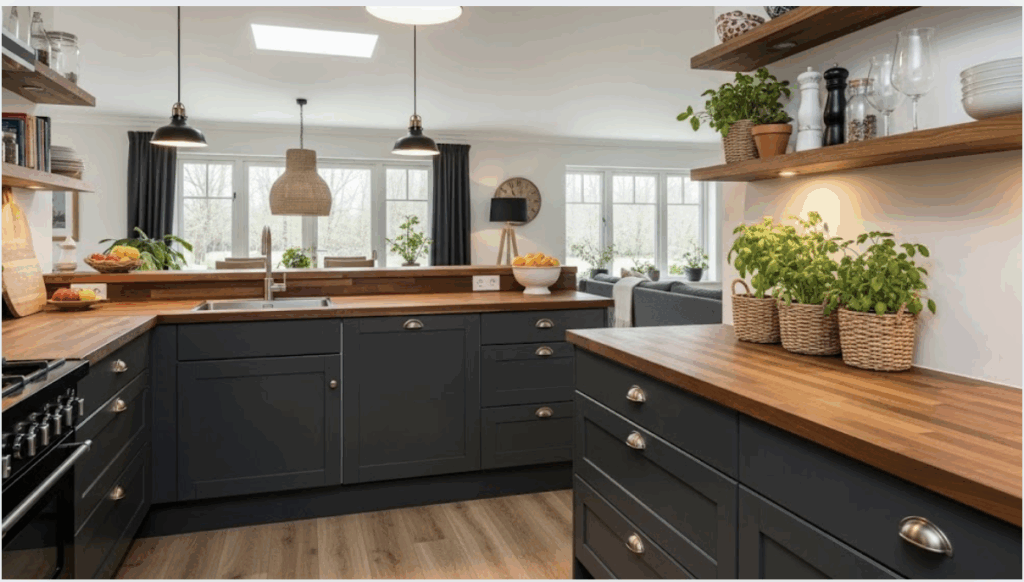
Butcher block countertops introduce warmth and organic texture, softening the bold presence of dark cabinetry.
The lighter wood grain offers contrast and a relaxed, homey feel. Ideal for rustic, farmhouse, or country-style kitchens, this surface brings a casual charm while still being functional and visually appealing.
4. Concrete or Concrete-Look Surfaces
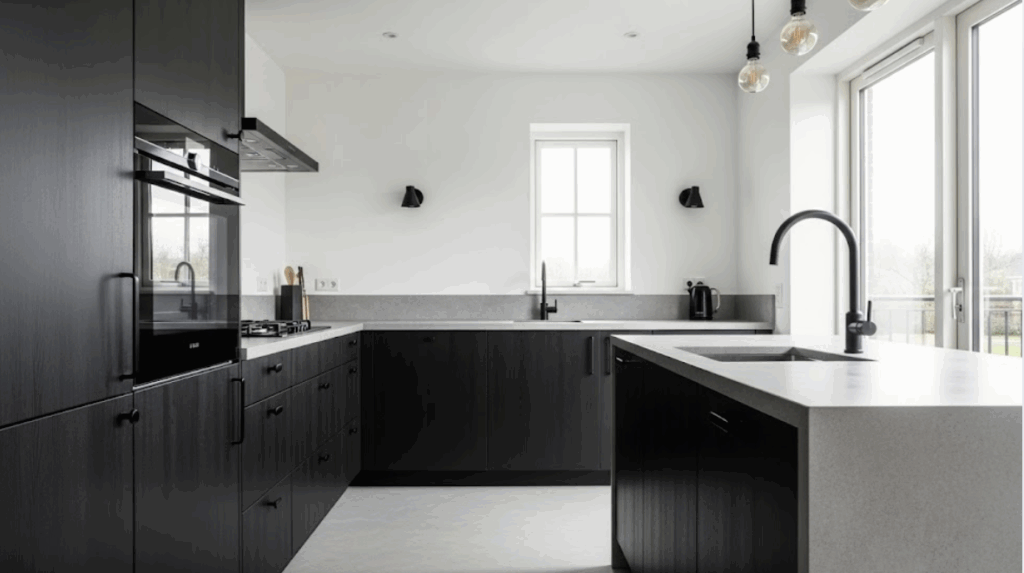
Concrete and concrete-look countertops offer a sleek, contemporary feel with a grounded, natural texture. Their soft gray tones provide a striking contrast to dark cabinets and pair seamlessly with matte black, silver, or stainless steel hardware.
This combination is ideal for modern, industrial, or minimalist kitchen designs seeking clean lines and balance.
Best Flooring Options for Dark Kitchen Cabinets
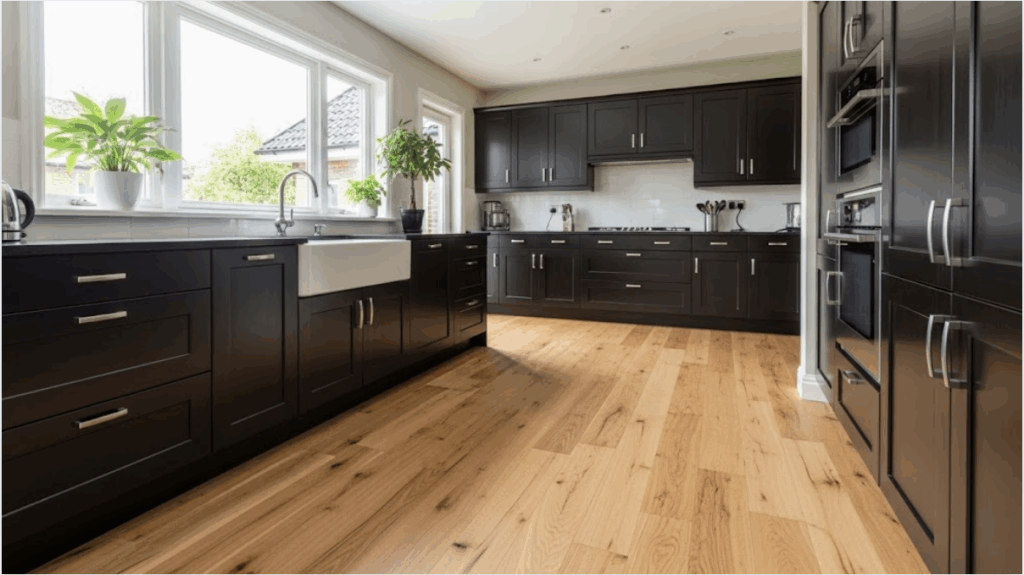
Flooring anchors the space visually. With dark cabinetry, your floor should either add warmth or reflect light to balance the look.
1. Light Wood Floors
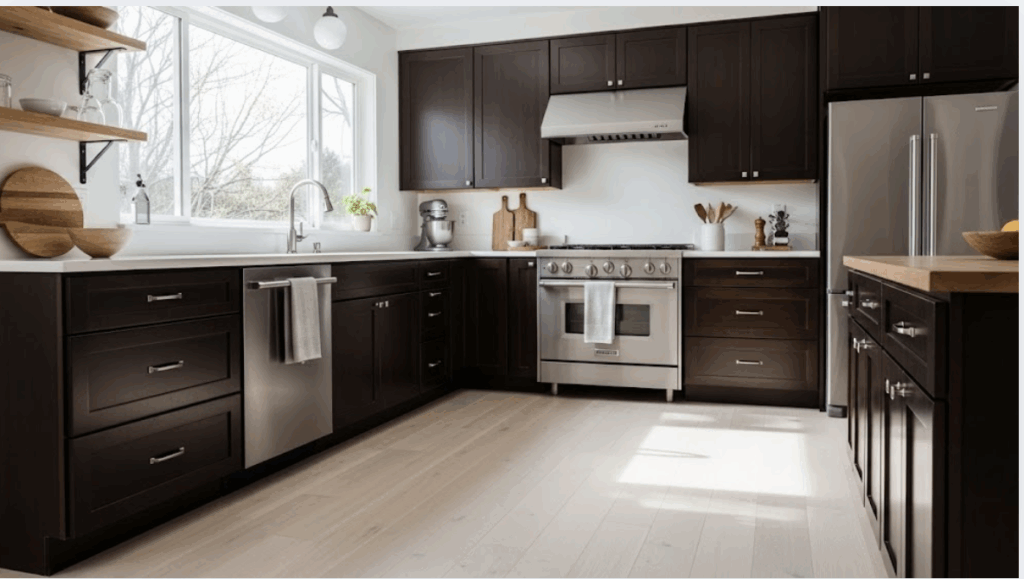
Light-toned woods such as maple or white oak brighten the space by reflecting light and adding visual contrast to dark cabinets.
They’re especially effective in compact kitchens or rooms with minimal natural light, helping the area feel larger and more open while maintaining a warm, inviting atmosphere.
2. Medium Brown Tones
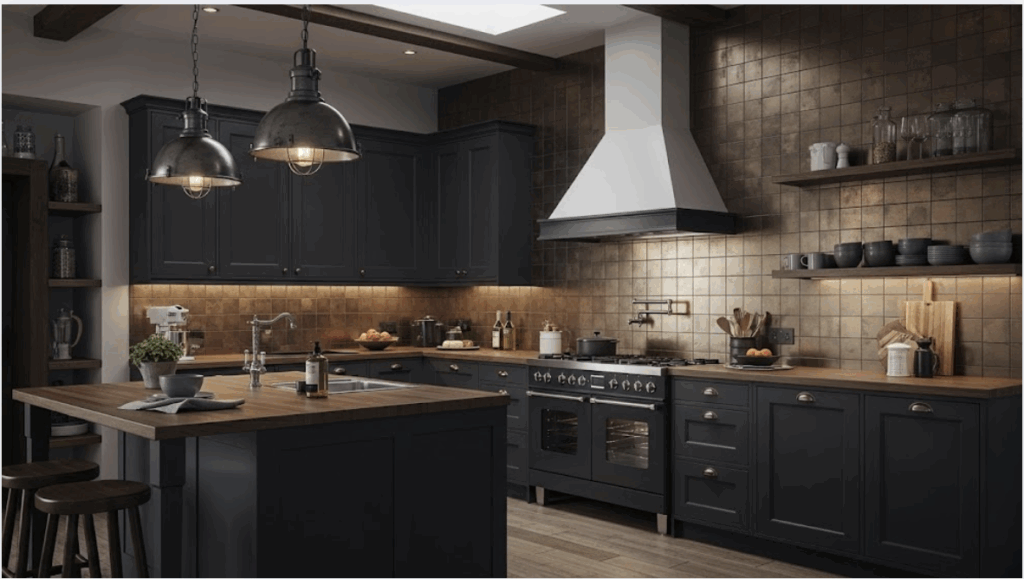
Medium brown flooring brings warmth and depth without closely matching dark cabinetry, preventing the space from feeling too heavy. Its balanced tone helps create visual separation while maintaining harmony.
This choice adds a layered, unified look that works well across various design styles, from classic to contemporary kitchen settings.
3. Patterned Tile
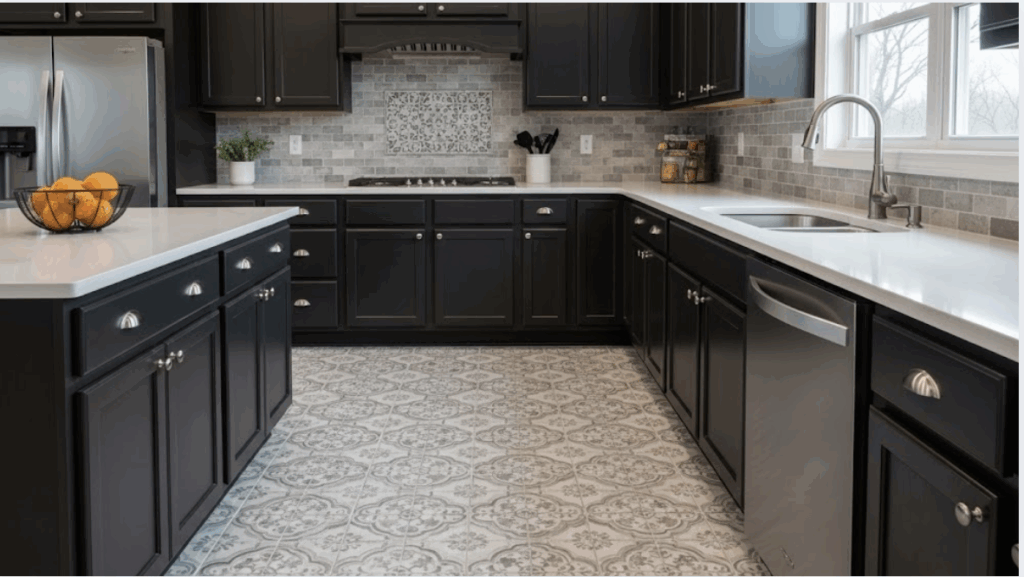
Patterned tiles introduce visual interest and gentle contrast without overwhelming the space. With soft tones or neutral designs, they add character and charm while blending seamlessly with your kitchen’s overall color scheme.
This makes them a smart choice for grounding the room while keeping it stylish and balanced.
4. Gray or Concrete Tile
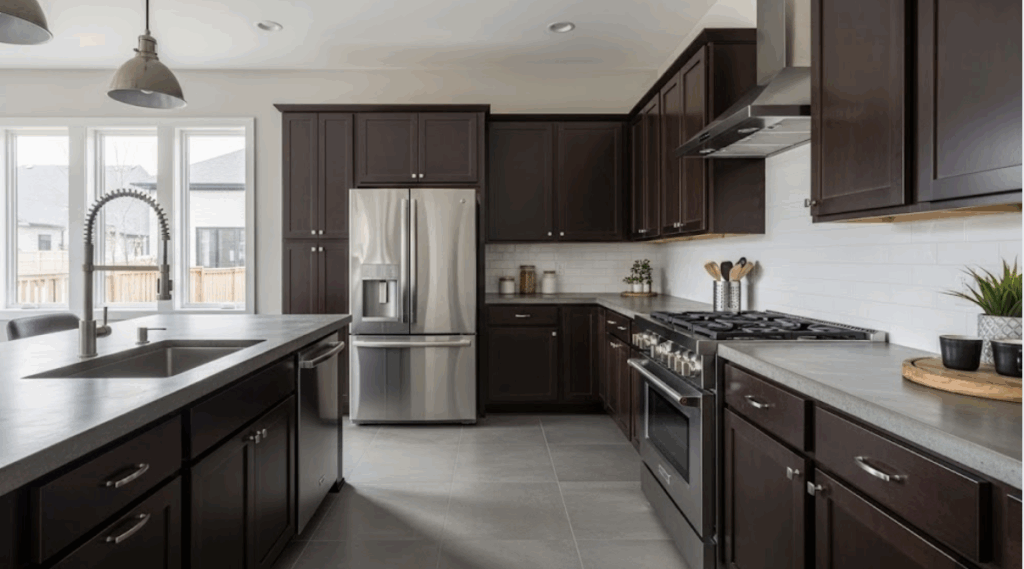
Gray tiles provide a sleek, neutral foundation that complements the boldness of dark cabinets. Their subtle tone helps balance the space visually while maintaining a modern edge.
Ideal for urban, industrial, or minimalist kitchens, gray flooring adds versatility and pairs easily with various wall colors, backsplashes, and hardware finishes.
How to Add Pops of Color to a Dark Kitchen
Once your main palette is set, accent colors help bring everything together. They’re easy to swap out and add visual interest.
Accent Colors to Try
- Terracotta – Adds warmth and a rustic edge
- Mustard Yellow – Brightens up cooler tones
- Soft Blush or Coral – Brings a gentle pop of color
- Teal or Aqua – Great for coastal or mid-century styles
- Charcoal or Black – Reinforces a bold, modern look
Use accent colors in rugs, dishware, stools, or lighting to create subtle but effective highlights.
Quick Color Combinations Based on Cabinet Color
Use these combinations to quickly pull together a cohesive look based on your cabinet shade.
|
Cabinet Color |
Wall Color |
Countertop |
Flooring |
|
Black |
Crisp white or light gray |
White quartz or marble |
Light oak or patterned tile |
|
Espresso |
Warm beige or greige |
Butcher block or veined granite |
Medium brown hardwood |
|
Navy |
Soft gray or dusty blue |
White or light gray quartz |
White oak or matte tile |
|
Charcoal |
Greige or soft sage |
Concrete-look or marble |
Patterned or gray tile |
Conclusion
When I finished pairing my espresso cabinets with soft gray walls, white counters, and maple floors, the whole room finally clicked.
It felt brighter, more open, and still had the boldness I loved.
Dark cabinets can absolutely shine when matched with the right supporting colors. The key is contrast, light reflection, and a sense of warmth.
Light or mid-toned walls, clean countertops, and textured backsplashes help balance the room visually. Accent shades and smart flooring finish the look.
Ultimately, it’s not just about how your kitchen looks; it’s about how it feels every day.
With the right color palette, your kitchen can feel bold and comfortable at once.

